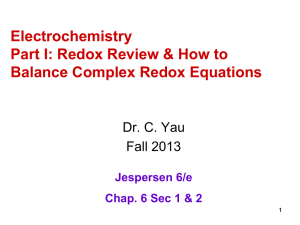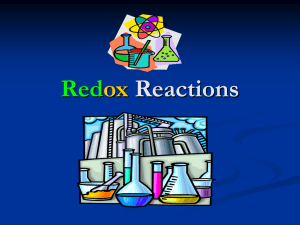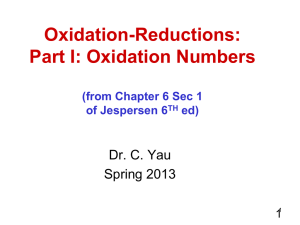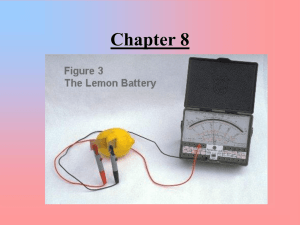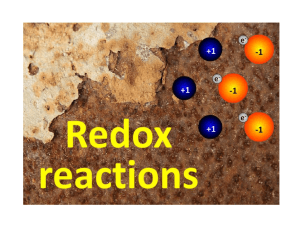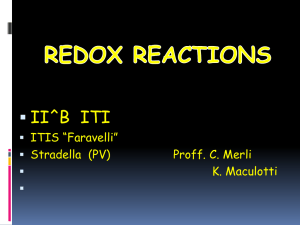student handout
advertisement
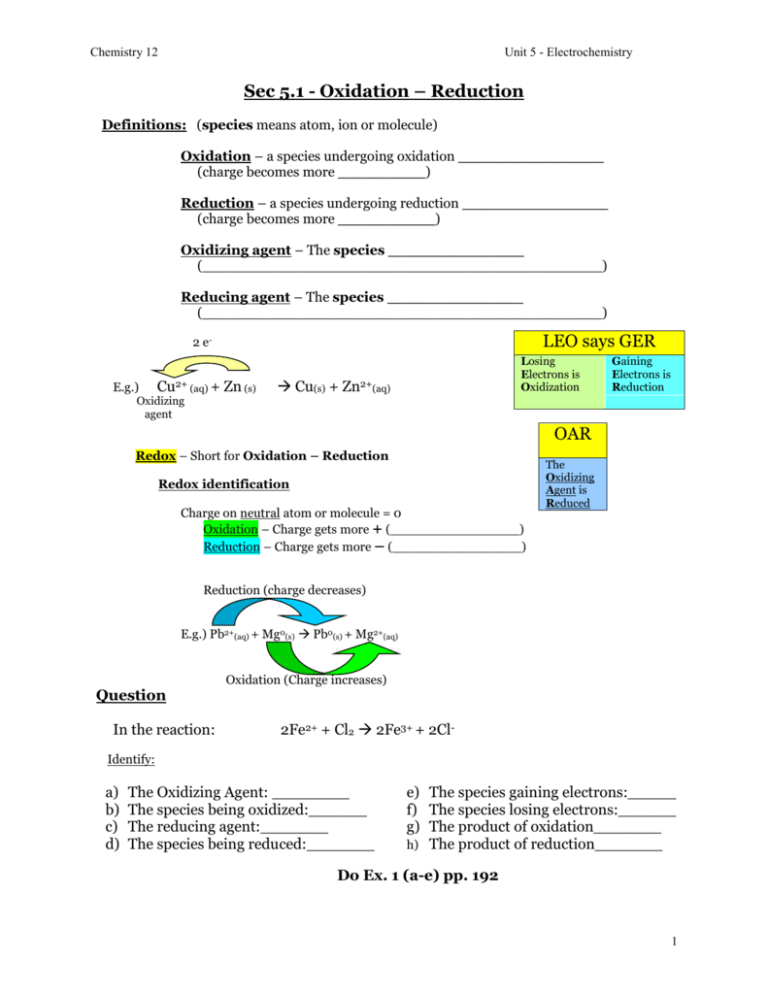
Chemistry 12 Unit 5 - Electrochemistry Sec 5.1 - Oxidation – Reduction Definitions: (species means atom, ion or molecule) Oxidation – a species undergoing oxidation _______________ (charge becomes more _________) Reduction – a species undergoing reduction _______________ (charge becomes more __________) Oxidizing agent – The species ______________ (_____________________________________________) Reducing agent – The species ______________ (_____________________________________________) LEO says GER 2 eE.g.) Cu2+ (aq) + Zn (s) Losing Electrons is Oxidization Cu(s) + Zn2+(aq) Gaining Electrons is Reduction Oxidizing agent OAR Redox – Short for Oxidation – Reduction Redox identification Charge on neutral atom or molecule = 0 Oxidation – Charge gets more + (________________) Reduction – Charge gets more – (________________) The Oxidizing Agent is Reduced Reduction (charge decreases) E.g.) Pb2+(aq) + Mg0(s) Pb0(s) + Mg2+(aq) Oxidation (Charge increases) Question In the reaction: 2Fe2+ + Cl2 2Fe3+ + 2Cl- Identify: a) b) c) d) The Oxidizing Agent: ________ The species being oxidized:______ The reducing agent:_______ The species being reduced:_______ e) The species gaining electrons:_____ f) The species losing electrons:______ g) The product of oxidation_______ h) The product of reduction_______ Do Ex. 1 (a-e) pp. 192 1 Chemistry 12 Unit 5 - Electrochemistry Half-Reactions -Redox reactions can be broken up into oxidation & reduction half reactions. e.g.) Redox rxn: Pb2+(aq) + Zn(s) Pb(s) + Zn2+(aq) The Pb2+ (loses/gains) __________ 2 electrons. Reduction Half-rx: Pb2+(aq) + 2e- Pb(s) Electrons on the LEFT side (or GER) Means REDUCTION Write the oxidation half reaction for the following redox rxn. Pb2+(aq) + Zn(s) Pb(s) + Zn2+(aq) Oxidation half rxn: ___________________________ (In oxidation reactions, e-‘s are _______ and are found on the ____ side.) (LEO) Note: Half-rxn’s always have e-‘s, redox (oxidation-reduction) reactions never show e-‘s! Given the redox reaction: F2(g) + Sn2+(aq) 2F-(aq) + Sn4+(aq) Write the oxidation half-rx:__________________________ Write the reduction half-rx:__________________________ Do ex. 2 a-c on p. 192 Sec 5.2 Oxidation numbers -Real or apparent charge on an atom in a molecule or ion Rules to find the oxidation number of an atom 1) In elemental form: (Single atoms of monatomic elements) or (diatomic molecules of diatomic elements) Oxidation number of atoms = 0 Eg) Mn, Cr, N2, F2, Sn, O2, etc. 2) In monatomic ions: oxidation # = charge ex; Na+ = +1 3) In ionic compounds a) the oxidation # of Alkali Metals is always +1 eg) NaCl K2CrO4 b) the oxidation # of Halogens when at the end (right side) of the formula is always –1 eg) CaCl2 AlBr3 KF 2 Chemistry 12 Unit 5 - Electrochemistry Note: Halogens are not always –1! (Only when it is written last in formula.) 4) In molecules or polyatomic ions: a) Oxidation. # of oxygen is almost always –2 e.g.) KOH CrO42- Li3PO4 b) An exception is Peroxides in which ox. # of O = -1 Hydrogen Peroxide: H2O2 Alkali Peroxides: Na2O2 (Remember, “O” in O2 has an Ox. # of ______) 5) In molecules or ions: a) Hydrogen is usually +1 e.g.) HNO3 H2SO4 HPO42- Every “H” has an ox # of +1 b) An exception is metallic hydrides, which have an ox # of -1 e.g.) NaH CaH2 (In each one of these Ox. # of H = -1) (What is the ox # of “H” in NH3? _______) (And remember ox # of “H” in H2 = ______) Finding oxidation numbers of each atom in a molecule In a neutral molecule the total charge = 0 e.g.) NH3 Total charge = 0 (no charge) In a polyatomic ion – the total ionic charge is written on the top right e.g.) CrO42- Total ionic charge (TIC) = -2 Oxidation numbers of all atoms add up to total ionic charge (TIC) e.g.) Find the oxidation # of Cr in CrO42(Let x = ox # of one Cr atom) CrO42X + 4 [# of “O”atoms] (-2 [charge of oxygen]) = -2 [total ionic charge] X – 8 = -2 X = -2 + 8 X = +6 So ox # of Cr here = +6 e.g.) Find ox # of Cl in HClO4 HClO4 +1 + x + 4 (-2) = 0 1+x–8=0 x – 7 = 0 x = +7 3 Chemistry 12 Unit 5 - Electrochemistry e.g.) Find Ox # of Cr in Cr2O72- e.g.) Find ox # of P in Li3PO4 Find Ox # of the underlined element in each of the following: a) NaH2PO4 _____ b) Na2O2 ______ c) KH ______ Find the ox # of Fe in Fe3O4 Find the ox # of As in As3O5 Read p. 193-194. Do Exercise 3 on p. 194. Changes in oxidation numbers When an atom’s oxidation # is increased, it is oxidized. e.g.) Half-rxn: Fe2+ Fe3+ + e- More complex: -When Mn3+ changes to MnO4-, is Mn oxidized or reduced? Mn3+ MnO4- - What is the ox # of Mn before & after the reaction? Before ___ After ___ - The ox # of Mn is (de/in)____creased. - In this process, Mn is (oxidized/reduced)__________________ Reduction – When an atom’s oxidation # is decreased, it is reduced. e.g.) Cu(NO3)2 Cu(s) Ox # of Cu = +2 Ox # decreases (reduction) Ox # of Cu = 0 4 Chemistry 12 Unit 5 - Electrochemistry Redox ID using oxidation #’s Given a more complex equation – identify atoms which do not change ox #’s (often “O” or “H” but not always!) e.g.) 3SO2 + 3H2O + ClO3- 3SO42- + 6H+ + Cl- There are no O2 molecules or peroxides, so “O” in all these has an ox # = -2 H is (+1) in both of these so it doesn’t change The only atoms left are “S” and “Cl”. Find the Ox #’s of S and Cl- in species that contain them. (Ox # of 1 atom in each case) 3SO2 3SO42SO2 Coefficients are just for balancing. SO42- Ox # of S is +4 Ox # of S increases so S is being oxidized Ox # of S is +6 Note: R.A.O., the reducing agent is oxidized The species SO2 is acting as the reducing agent. The element S is being oxidized so S is losing electrons. Look at the species with Cl: ClO3- Ox. # of Cl = +5 Cl- Decrease in ox # so Cl is being _________ Ox. # of Cl = -1 Therefore, the species acting as the oxidizing agent is __________. Eg. given the reaction: 2CrO42- + 3HCHO + 2H2O 2Cr(OH)3 + 3HCOO- + OH- Notes: For hydrocarbons it’s best to rewrite them as simple molecular formulas. All O’s are in molecules or ions, no O2 & no peroxides so O remains unchanged as -2 All H’s are in molecules or ions, no H2 or metallic hydrides so H remains unchanged as +1 The atoms to check for changes are C and Cr. Oxidation 0 +2 2CrO42- + 3CH2O + 2H2O 2Cr(OH)3 + 3HCO2- + OH+6 +3 Reduction Find: a) The species being oxidized - _______ b) The reducing agent - _______ c) The species being reduced- _______ d) The oxidizing agent - _______ e) The species losing electrons - ______ f) The species gaining electrons - _____ 5 Chemistry 12 Unit 5 - Electrochemistry Given the redox reaction: 2MnO4- + 3C2O42- + 4H2O 2MnO2 + 6CO2 + 8OHFind: a) b) c) d) e) f) The species being reduced: _____________. The species undergoing oxidation: _____________. The oxidizing agent: ________________. The reducing agent: ________________. The species gaining electrons: ______________. The species losing electrons: ______________. Given the balanced redox reaction: 3S + 4HNO3 3SO2 + 4NO + 2H2O Find: a) b) c) d) e) f) g) h) The oxidizing agent: _____________. The reducing agent: _____________. The species being reduced: ___________. The species being oxidized: ___________. The species losing electrons: ____________. The species gaining electrons: ____________. The product of oxidation: ____________. The product of reduction: ____________. Given the following: 6Br2 + 12KOH 10KBr + 2KBrO3 + 6H2O Find: a) b) c) d) e) f) The oxidizing agent: ______________. The reducing agent: ______________. The species undergoing oxidation: _____________. The species being reduced: ________________. The product of oxidation: _______________. The product of reduction: _______________. 6 Chemistry 12 Unit 5 - Electrochemistry Using oxidation numbers to identify half-reactions They don’t have to be balanced e.g.) If NO2- NO3- is an example of (oxidation or reduction?) _______________. (“O” does not change it’s ox # (no O 2 or peroxides)) so find ox # of N on both sides. NO2- NO3Ox # = +3 Since ox # increases, this is an oxidation Ox # = +5 O.N. = +2 e.g.) H2O2 H2 O Ox # = -1 Ox # = -2 O.N. = -1 This time “O” is the element changing ox # Ox # if “O” decreases so this is a reduction Find the O.N. of the element in which it changes and identify each as an oxidation or reduction a) C2H5OH CH3COOH ________________________________ b) Fe2O3 Fe3O4 ______________________________________ c) H3PO4 P4 ______________________________________ (P4 is the elemental form of phosphorus) d) CH3COOH CH3COH ________________________________ NOTE: When asked if a given reaction is a redox or not: Look for a change from an element compound or compound an element These will always be redox, because in elemental form ox. # = 0 and in compounds usually ox. # is not = 0 0 +2 Eg.) Is the reaction: Zn + Cl2 ZnCl2 a redox reaction? 0 -1 Answer: It must be because ON of Zn ( 0 +2 = +2) and ON of Cl (0 -1 = -1) Do Exercises 4, 5 and 6 on p. 194-195. 7


